 Mooie werken, allemaal gebaseerd op rampspoed, politiek falen of schrijnende situaties in de wereld. In deze expo ook een aantal werken die ik al eerder zag. Zo is de installatie van fietsen hier een centraal werk. Waar ik die zag, weet ik niet meer. Maar uit de expo in Cambridge was hier behang gemaakt en het trio aan foto’s waarop WeiWei een oude Mingvaas vernietigt hing er ook. En eerder zag ik het werk met de duizenden zonnebloemzaadjes al. Ook van deze weet ik niet precies waar. Maar er hingen en stonden ook veel nieuwe werken, die ik niet eerder zag. Zo vond ik het werk van het verwrongen vlechtstaal misschien wel het meest indrukwekkend: vlechtstaal uit scholen die tijdens een aardbeving het begaven, vanwege het gebruik van ondermaatse materialen met als gevolg heel veel dode kinderen, en ouders die bij hun zoektocht naar hun kinderen gearresteerd waren omdat de Chinese overheid de waarheid wilde verdoezelen. Bijzonder goede expo.
Mooie werken, allemaal gebaseerd op rampspoed, politiek falen of schrijnende situaties in de wereld. In deze expo ook een aantal werken die ik al eerder zag. Zo is de installatie van fietsen hier een centraal werk. Waar ik die zag, weet ik niet meer. Maar uit de expo in Cambridge was hier behang gemaakt en het trio aan foto’s waarop WeiWei een oude Mingvaas vernietigt hing er ook. En eerder zag ik het werk met de duizenden zonnebloemzaadjes al. Ook van deze weet ik niet precies waar. Maar er hingen en stonden ook veel nieuwe werken, die ik niet eerder zag. Zo vond ik het werk van het verwrongen vlechtstaal misschien wel het meest indrukwekkend: vlechtstaal uit scholen die tijdens een aardbeving het begaven, vanwege het gebruik van ondermaatse materialen met als gevolg heel veel dode kinderen, en ouders die bij hun zoektocht naar hun kinderen gearresteerd waren omdat de Chinese overheid de waarheid wilde verdoezelen. Bijzonder goede expo.
Category Archives: 20e eeuw
Ai WeiWei. In search of humanity. Kunsthal Rotterdam
Palácio da Cultura Ildo Lobo. Praia, Santiago, Kaapverdië
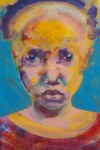 Het Palacia da Cultura Ildo Lobo is een kleine expositieruimte met kunst van lokale, Kaapverdische kunstenaars. Niet alle werken zijn even overtuigend,maar de werken van Adilio Felsing spraken me meteen aan. Het leuke is wel dat ik één van de geexposeerde kunstenaars een paar dagen ervoor in Cidade Velha de hand schudde (Rita Fernandes) en van andere door de stad al werken in de vorm van street art had gezien, zoals Tutu Sousa en Helder Cardoso. Wat grappig is, is dat de museumwinkel heel erg professioneel opgezet was, meer dan de exporuimte zelf. Naast het museum voor hedendaagse kunst in Mindelo, het leukste culturele uitstapje van Kaapverdië.
Het Palacia da Cultura Ildo Lobo is een kleine expositieruimte met kunst van lokale, Kaapverdische kunstenaars. Niet alle werken zijn even overtuigend,maar de werken van Adilio Felsing spraken me meteen aan. Het leuke is wel dat ik één van de geexposeerde kunstenaars een paar dagen ervoor in Cidade Velha de hand schudde (Rita Fernandes) en van andere door de stad al werken in de vorm van street art had gezien, zoals Tutu Sousa en Helder Cardoso. Wat grappig is, is dat de museumwinkel heel erg professioneel opgezet was, meer dan de exporuimte zelf. Naast het museum voor hedendaagse kunst in Mindelo, het leukste culturele uitstapje van Kaapverdië.
Sala-Museu Amilcar Cabral. Praia, Santiago, Kaapverdië
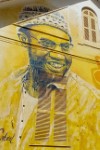 Het museum van de Kaapverdische verzetsheld, vrijheidsstrijder Amilcar Cabral is weer een zelfde soort van knulligheid als eigenlijk de meeste ‘musea’ in Kaapverdië. Pas ergens in de laatste ruimte kwam het chronologische verhaal van Amilcar Cabral aan bod, er zijn een aantal kledingstukken en eigendommen van Cabral maar het opvallendst is de muts die Cabral kreeg van een boer die later zijn kenmerkende verschijning zou bepalen. Een muts.
Het museum van de Kaapverdische verzetsheld, vrijheidsstrijder Amilcar Cabral is weer een zelfde soort van knulligheid als eigenlijk de meeste ‘musea’ in Kaapverdië. Pas ergens in de laatste ruimte kwam het chronologische verhaal van Amilcar Cabral aan bod, er zijn een aantal kledingstukken en eigendommen van Cabral maar het opvallendst is de muts die Cabral kreeg van een boer die later zijn kenmerkende verschijning zou bepalen. Een muts.
Centro Nacional de Arte, Artesanato e Design. Mindelo, Sao Vicente, Kaapverdië
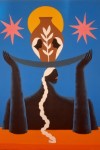 Op het allerlaatste moment in Mindelo zo ongeveer kom ik het CNAD tegen. Van een afstand had ik de kleurrijke façade al gezien maar dacht dat het een winkelcentrum of iets dergelijks was. Een verrassing dus, dat het een bijzonder leuk museum was met kunst van lokale kunstenaars. Zo hingen er veel werken van Manuel Figueira. Was er de expositie Memórias e sentimentos van Gildoca Barros (foto) in sterken kleuren in eenvoudige vormen. Van Gildoca Barros (vrouw) fotografeerde ik trouwens in Boa Vista al een street art werk. En verder hingen er historisch relevante geweven doeken onder de noemer ‘Cape Verderan Creations’, lokale handicrafts zoals bootjes van horens etc. Een erg leuk museum om te bezoeken, en de museumwinkel moet je zeker niet overslaan.
Op het allerlaatste moment in Mindelo zo ongeveer kom ik het CNAD tegen. Van een afstand had ik de kleurrijke façade al gezien maar dacht dat het een winkelcentrum of iets dergelijks was. Een verrassing dus, dat het een bijzonder leuk museum was met kunst van lokale kunstenaars. Zo hingen er veel werken van Manuel Figueira. Was er de expositie Memórias e sentimentos van Gildoca Barros (foto) in sterken kleuren in eenvoudige vormen. Van Gildoca Barros (vrouw) fotografeerde ik trouwens in Boa Vista al een street art werk. En verder hingen er historisch relevante geweven doeken onder de noemer ‘Cape Verderan Creations’, lokale handicrafts zoals bootjes van horens etc. Een erg leuk museum om te bezoeken, en de museumwinkel moet je zeker niet overslaan.
Centro Cultural do Mindelo. Mindelo, Sao Vicente, Kaapverdië
 Op zoek naar het Cesaria Evoramuseum kwam ik al een aantal keren langs het cultureel centrum van Mindelo. Vanuit de ingang zie ik geweven kleden, geweven op historische en culturele wijze. Verder is er niet heel erg veel te zien. Wel is de giftshop leuk, en een goeie indicatie van prijzen voor hebbedingen die ik op de markt wil kopen. Het Cesaria Evoramuseum vergeet ik verder te bezoeken. Handig.
Op zoek naar het Cesaria Evoramuseum kwam ik al een aantal keren langs het cultureel centrum van Mindelo. Vanuit de ingang zie ik geweven kleden, geweven op historische en culturele wijze. Verder is er niet heel erg veel te zien. Wel is de giftshop leuk, en een goeie indicatie van prijzen voor hebbedingen die ik op de markt wil kopen. Het Cesaria Evoramuseum vergeet ik verder te bezoeken. Handig.
Rare Earth. Tony Cragg. Museo Nacional de Arte Contemporanea do Chiado. Lissabon, Portugal
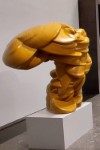 Drie maanden eerder stond ik nog naast de grote sculptuur van Cragg voor het Heydar Aliyev Cultural Center in Baku. Nu sta ik tussen de prachtige sculpturen van Cragg in een historisch gebouw in Lissabon. Het is een klein museum met een wat rare entree maar de ruimte laat de werken van Cragg goed tot zijn recht komen, met schitterende verlichting en balans in de ruimtes. Verrassend zijn de werken die juist helemaal niet aan de bekende stijl van Cragg doen denken, en de tekeningen en schilderijen. En dat er ook nog een aantal sculpturen in de publieke ruimte staan, op het Praça do Comercio, is alleen maar een bonus.
Drie maanden eerder stond ik nog naast de grote sculptuur van Cragg voor het Heydar Aliyev Cultural Center in Baku. Nu sta ik tussen de prachtige sculpturen van Cragg in een historisch gebouw in Lissabon. Het is een klein museum met een wat rare entree maar de ruimte laat de werken van Cragg goed tot zijn recht komen, met schitterende verlichting en balans in de ruimtes. Verrassend zijn de werken die juist helemaal niet aan de bekende stijl van Cragg doen denken, en de tekeningen en schilderijen. En dat er ook nog een aantal sculpturen in de publieke ruimte staan, op het Praça do Comercio, is alleen maar een bonus.
Cobra. De vrijheidsschreeuw. Cobra 75. Cobra Museum voor Moderne Kunst. Amstelveen
 Mooie expositie, die volgens mij heel anders is dan de vorige keer dat ik het Cobramuseum bezocht. Met werken van bekende maar ook bekende schilders van Cobra, en schilders die tot aanverwante stromingen gerekend worden: Karel Appel, Constant, maar ook Christian Dotremont etc.
Mooie expositie, die volgens mij heel anders is dan de vorige keer dat ik het Cobramuseum bezocht. Met werken van bekende maar ook bekende schilders van Cobra, en schilders die tot aanverwante stromingen gerekend worden: Karel Appel, Constant, maar ook Christian Dotremont etc.
Tina Modotti. FOAM Amsterdam
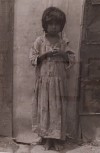 Fotografie van Tina Modotti uit Mexico in het begin van de jaren 90. Niet mijn ding.
Fotografie van Tina Modotti uit Mexico in het begin van de jaren 90. Niet mijn ding.
Foñana – Contemporary Female Artists from Saudi Arabia. FOAM Amsterdam
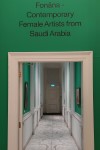 Indrukwekkende expositie waarin Saudi Arabische vrouwen ruimte voor zichzelf en hun kunst opeisen. Ik was vooral gecharmeerd van Food for Thought, Fetwa 3 van Maha Malluh uit 2018, waarin ze oude cassettebandjes met vrouwonvriendelijke religieuze preken verwerkt tot een schilderij, die met zachte pastelkleuren het gevaar van deze cassettebandjes verbergen.
Indrukwekkende expositie waarin Saudi Arabische vrouwen ruimte voor zichzelf en hun kunst opeisen. Ik was vooral gecharmeerd van Food for Thought, Fetwa 3 van Maha Malluh uit 2018, waarin ze oude cassettebandjes met vrouwonvriendelijke religieuze preken verwerkt tot een schilderij, die met zachte pastelkleuren het gevaar van deze cassettebandjes verbergen.
Van Gogh aan de Seine. Van Gogh Museum, Amsterdam
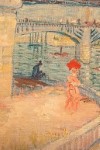 Schitterende expo van Van Gogh en tijdgenoten Seurat, Bernard, Signac en Angrand, die allen werkten aan de oevers van de Seine, net buiten de stad Parijs. Vooral Asnières was populair, ondanks de industrialisering van het gebied na verloop van tijd. In de expo van de schilders zie je de ontwikkeling in de tijd. Erg de moeite waard.
Schitterende expo van Van Gogh en tijdgenoten Seurat, Bernard, Signac en Angrand, die allen werkten aan de oevers van de Seine, net buiten de stad Parijs. Vooral Asnières was populair, ondanks de industrialisering van het gebied na verloop van tijd. In de expo van de schilders zie je de ontwikkeling in de tijd. Erg de moeite waard.
Boijmans van Beuningen in het Rijks. Rijksmuseum Amsterdam
 Erg fijne expositie met werken uit het Boijmans van Beuningen, die zo lang het museum niet open is, rondreizen naar verschillende andere musea. Ik zag een aantal interessante werken, die ik niet eerder zag, of waarvan ik de maker niet kende zoals The Car van Marisol (Escobar) of Salvador Dali’s Shirley Temple, le plus jeune monstre sacré du cinéma de son temps. Of Two Deckchairs van David Hockney. Maar het leukst was wel dat de Phalli Infinity Room van Yayoi Kusama helemaal verlaten erbij lag, toen ik kwam en ik dus meteen kon doorlopen en zonder tijdslimiet mocht genieten van de tientallen reflecties op de rood-wit gestipte fallussen.
Erg fijne expositie met werken uit het Boijmans van Beuningen, die zo lang het museum niet open is, rondreizen naar verschillende andere musea. Ik zag een aantal interessante werken, die ik niet eerder zag, of waarvan ik de maker niet kende zoals The Car van Marisol (Escobar) of Salvador Dali’s Shirley Temple, le plus jeune monstre sacré du cinéma de son temps. Of Two Deckchairs van David Hockney. Maar het leukst was wel dat de Phalli Infinity Room van Yayoi Kusama helemaal verlaten erbij lag, toen ik kwam en ik dus meteen kon doorlopen en zonder tijdslimiet mocht genieten van de tientallen reflecties op de rood-wit gestipte fallussen.
Sol LeWitt. Joods Museum. Amsterdam
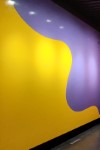 Een lastige keuze: nu Israël Gaza vernietigt, kun je dan nog met goed fatsoen naar een Joods museum. Op het moment dat dit speelde, dacht ik dat wel kon. Nu, weken later, zou ik diezelfde keuze niet licht maken. Het blijft lastig, de scheidslijn tussen niet alle Israëliers steunen de vernietiging en Israëliers zien als vertegenwoordigers van hun regering. Deze expositie was trouwens wel de moeite waard. Niet eerder zag ik een expo gewijd aan LeWitt alleen.
Een lastige keuze: nu Israël Gaza vernietigt, kun je dan nog met goed fatsoen naar een Joods museum. Op het moment dat dit speelde, dacht ik dat wel kon. Nu, weken later, zou ik diezelfde keuze niet licht maken. Het blijft lastig, de scheidslijn tussen niet alle Israëliers steunen de vernietiging en Israëliers zien als vertegenwoordigers van hun regering. Deze expositie was trouwens wel de moeite waard. Niet eerder zag ik een expo gewijd aan LeWitt alleen.
Amsterdam Museum in H’ART museum. Amsterdam
 Deze expositie heb ik al een keer gezien, ontdekte ik toen ik de expo bezocht. Met werken van Raquel Haver, Brian Elstak en Natasha Kensmil onder andere.
Deze expositie heb ik al een keer gezien, ontdekte ik toen ik de expo bezocht. Met werken van Raquel Haver, Brian Elstak en Natasha Kensmil onder andere.
Yayoi Kusama. De Nederlandse jaren 1965-1970. Stedelijk Museum, Schiedam
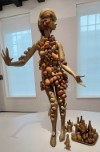 De expositie over de Nederlandse jaren van Yayoi Kusama, waar ik tot deze expo niets van wist, stond al weken op mijn verlanglijstje maar Schiedam is wel een enorme trek vanaf Enschede. Vanuit Amersfoort maar een keer doorgereisd. En de expositie stelt niet teleur. Het is een soort verslaglegging van Yayoi Kusama’s ontstaansgeschiedenis met ook werken die je niet meteen aan haar zou koppelen. Erg interessant en de moeite van de reis ernaartoe zeker waard.
De expositie over de Nederlandse jaren van Yayoi Kusama, waar ik tot deze expo niets van wist, stond al weken op mijn verlanglijstje maar Schiedam is wel een enorme trek vanaf Enschede. Vanuit Amersfoort maar een keer doorgereisd. En de expositie stelt niet teleur. Het is een soort verslaglegging van Yayoi Kusama’s ontstaansgeschiedenis met ook werken die je niet meteen aan haar zou koppelen. Erg interessant en de moeite van de reis ernaartoe zeker waard.
Welt auf Papier. Tàpies Miró. Kunstmuseum Pablo Picasso. Münster, Duitsland
 De tentoonstelling Welt auf Papier in het kader van de 100e geboortedag van Antoni Tàpies en de 130e van Joan Miro in het Pablo Picasso Museum is de moeite waard. Het is bijna bizar hoeveel gelijkenis er in de stijl van beide schilders is, maar toch ook een eigenheid. Met meer dan 100 werken, een flinke expositie.
De tentoonstelling Welt auf Papier in het kader van de 100e geboortedag van Antoni Tàpies en de 130e van Joan Miro in het Pablo Picasso Museum is de moeite waard. Het is bijna bizar hoeveel gelijkenis er in de stijl van beide schilders is, maar toch ook een eigenheid. Met meer dan 100 werken, een flinke expositie.
Nudes. LWL-Museum für Kunst und Kultur. Münster, Duitsland
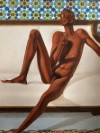 Nudes in het LWL in Münster is een expositie in samenwerking met Tate London. De expositie toont naakten door de jaren heen. Van het historisch perspectief, privé, kwetsbare en moderne naakten. De expositie raakt onderwerpen als gender, identiteit, de mannelijke blik op vrouwelijk naakt maar ook de politieke boodschap van naakten.
Nudes in het LWL in Münster is een expositie in samenwerking met Tate London. De expositie toont naakten door de jaren heen. Van het historisch perspectief, privé, kwetsbare en moderne naakten. De expositie raakt onderwerpen als gender, identiteit, de mannelijke blik op vrouwelijk naakt maar ook de politieke boodschap van naakten.
Een expo met 90 werken van indrukwekkende namen, Auguste Rodin, Francis Bacon, Zanele Muholi, Marlene Dumas, Pablo Picasso, Alice Neel, Tracey Emin and the Guerilla Girls uit het Tate, aangevuld met de eigen collectie van het LWL. Op de afbeelding een werk van Barkley L. Hendricks. Een aanrader om te gaan zien, deze expo.
A sense of brown CBK Zuidoost
 Tegen een achtergrond van 150 jaar Hindostaanse migratie adresseren 10 (inter)nationale kunstenaars – nazaten van Indiase contractarbeiders – het belang van zintuigelijke waarneming wanneer er wordt gereflecteerd op de (koloniale) geschiedenis en de huidige belichaming daarvan. Vertrekkend vanuit dekoloniale, intersectionele, (trans)feministische en queer referentiekaders tonen de kunstenaars hoe materie zelf een plek van verzet is, een connectie met de voorouders kan zijn en het proces van het vormen van nieuwe relaties tussen mensen en niet-menselijke entiteiten kan faciliteren.
Tegen een achtergrond van 150 jaar Hindostaanse migratie adresseren 10 (inter)nationale kunstenaars – nazaten van Indiase contractarbeiders – het belang van zintuigelijke waarneming wanneer er wordt gereflecteerd op de (koloniale) geschiedenis en de huidige belichaming daarvan. Vertrekkend vanuit dekoloniale, intersectionele, (trans)feministische en queer referentiekaders tonen de kunstenaars hoe materie zelf een plek van verzet is, een connectie met de voorouders kan zijn en het proces van het vormen van nieuwe relaties tussen mensen en niet-menselijke entiteiten kan faciliteren.
Heydar Aliyev Center – Baku, Azerbeidzjan
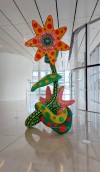 Van buiten is het Heyder Aliyev Center al enorm indrukwekkend. Van ver af zie je het gebouw al glimmen en glanzen. De architectuur van Zaha Hadid is oogverblindend. Naarmate dat je dichterbij komt, zie je de kleine barstjes in de façade. Letterlijk. Maar wat een spetterend gebouw. Van binnen biedt het meerdere verdiepingen met exposities. Van Azerbeidzjaanse muziekinstrumenten tot kleding. En natuurlijk een aantal kunstwerken zoals de glimmende zilverkleurige sculptuur van Tony Cragg voor de deur, of de Yayoi Kusama sculptuur meteen na de entree. De binnenkant moet je, alleen al voor de ervaring, niet overslaan. Maar combineer het met de exposities, dat maakt de ervaring ‘af’.
Van buiten is het Heyder Aliyev Center al enorm indrukwekkend. Van ver af zie je het gebouw al glimmen en glanzen. De architectuur van Zaha Hadid is oogverblindend. Naarmate dat je dichterbij komt, zie je de kleine barstjes in de façade. Letterlijk. Maar wat een spetterend gebouw. Van binnen biedt het meerdere verdiepingen met exposities. Van Azerbeidzjaanse muziekinstrumenten tot kleding. En natuurlijk een aantal kunstwerken zoals de glimmende zilverkleurige sculptuur van Tony Cragg voor de deur, of de Yayoi Kusama sculptuur meteen na de entree. De binnenkant moet je, alleen al voor de ervaring, niet overslaan. Maar combineer het met de exposities, dat maakt de ervaring ‘af’.
Musée La Boverie – Luik, België
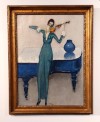 De collectie bevat Schone kunsten uit de stad Luik, met werken van Ingres, Monet, Magritte, Appel, van Dongen, Kokoschka, Marc, Chagall etc. Op het moment dat wij de expo bezochten, waren ze aan het verbouwen en was er een kleine collectie ten toon gesteld, en werd er flink getimmerd en gedaan. Een beetje een tegenvaller, stiekem.
De collectie bevat Schone kunsten uit de stad Luik, met werken van Ingres, Monet, Magritte, Appel, van Dongen, Kokoschka, Marc, Chagall etc. Op het moment dat wij de expo bezochten, waren ze aan het verbouwen en was er een kleine collectie ten toon gesteld, en werd er flink getimmerd en gedaan. Een beetje een tegenvaller, stiekem.
Escher. Andere wereld. Kunstmuseum Den Haag
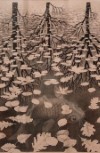 De Nederlandse kunstenaar Maurits Cornelis Escher (1898-1972) is een van de bekendste grafische kunstenaars ter wereld. Tot op de dag van vandaag fascineert hij door zijn spel met perspectief, ruimte en werkelijkheid. Het Kunstmuseum Den Haag bezit een van de grootste collecties van het werk van M.C. Escher. De hoogtepunten uit zijn oeuvre zijn te zien in ‘Escher in Het Paleis’.
De Nederlandse kunstenaar Maurits Cornelis Escher (1898-1972) is een van de bekendste grafische kunstenaars ter wereld. Tot op de dag van vandaag fascineert hij door zijn spel met perspectief, ruimte en werkelijkheid. Het Kunstmuseum Den Haag bezit een van de grootste collecties van het werk van M.C. Escher. De hoogtepunten uit zijn oeuvre zijn te zien in ‘Escher in Het Paleis’.
